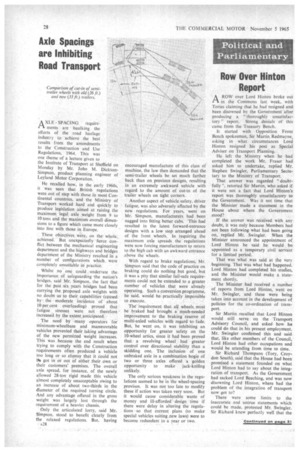Axle Spacings are Inhibiting Road Transport
Page 30

If you've noticed an error in this article please click here to report it so we can fix it.
A XLE SPACING require1-1 ments are baulking the efforts of the road haulage industry to achieve the best results from the amendments to the Construction and Use Regulations, 1964, This was one theme of a lecture given to the Institute of Transport at Sheffield on Monday by Mr. John M. DicksonSimpson, product planning engineer of• Leyland Motor Corporation.
He recalled how, in the early 1960s, It was seen that British regulations were out of step with those in most Continental countries, and the Ministry of Transport worked hard and quickly to produce legislation aimed at raising the maximum legal axle weight from 9 to 10 tons and the maximum overall dimensions to a figure which came more closely into line with those in Europe.
These objectives were, on the whole, achieved. But unexpectedly fierce conflict between the mechanical engineering department and the highways and bridges department of the Ministry resulted in a number of configurations which were completely unsuitable in practice.
Whilst no one could .. underrate the, importance. of safeguarding -the nation's bridges. said Mr. Simpson. the fact that for the past six -years bridges had been carrying the proposed axle weights with no doubt as to their capabilities (caused by the moderate incidence of about 10 per cent overloading) proved that fatigue stresses were not therefore increased by the extent anticipated. "
The need by •many operators for minimum-wheelbase and manceuvrable vehicles prevented their taking advantage of the new permitted weight increases. This Was because the end result when trying to comply with the Construction requirements often produced a vehicle too long or so clumsy that it could not 1/4 got in or out of either their own or their customers' premises. The overall axle spread, for instance, of the newly allowed 28-ton rigid made this vehicle almost completely unacceptable owing to an increase of about two-thirds in the diameter of the required turning circle. And any advantage offered in the gross weight was largely lost through the requirement of a heavier chassis.
Only the articulated lorry, ,said Mr. Simpson. stood to benefit clearly from the relaxed regulations. But, having A28 encouraged manufacture of this class of machine, the law then demanded that the
semi-trailer wheels be set much farther back than on previous designs, resulting in an extremely awkward vehicle with regard to the amount of cut-in of the trailer wheels on tight corners.
Another aspect of vehicle safety. driver fatigue, was also adversely affected by the new • regulations. For years, went on Mr. Simpson, manufacturers had been nagged into fitting better cabs. This had resulted in the latest forward-entrance designs with a low step arranged ahead of the front wheels. In requiring the maximum axle spreads the regulations were now forcing manufacturers to return to the high cab with an awkward entrance above the wheels.
With regard to brake regulations, Mr. Simpson said that the code of practice on braking could do nothing but good. but it was a pity that similar fail-safe requirements could not be extended to a greater number of vehicles that were already operating. Such a conversion programme, he said, would be. practically impossible to execute.
The requirement that al) wheels must be braked had brought a much-needed improvement to the braking reserve of multi-axled vehicles with regard to fade. But, he went on, it was inhibiting an opportunity for greater safety on the 10-wheel attics, since it had been proved that a revolving wheel had greater control over directional stability than a skidding one. The inclusion of one unbraked axle in a combination bogie of two or three axles offered a golden opportunity to make jack-knifing unlikely.
The only serious weakness in the regulations seemed to be in the wheel-spacing provisos. It was not too late to modify these if action was taken very soon. But it would cause considerable waste of money and ill-afforded • design time if there were delay in altering the regulations so that current plans (to make special vehicles suiting new laws) were to become redundant in a year or two.




















































































































